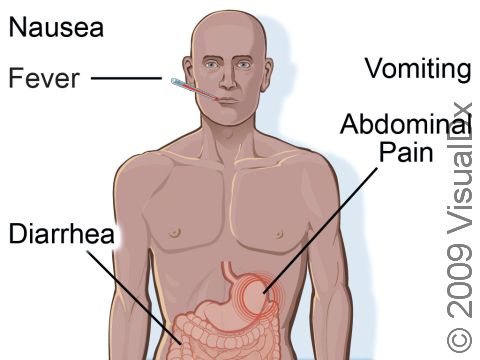Foodborne Illness (Food Poisoning), First Aid
Most foodborne illness, also known as food poisoning, comes from bacteria in food that has multiplied, either from poor handling, improper cooking, or poor storage of food. Other things, such as toxins, parasites, chemicals, and viruses, can contaminate food, but these causes are much less common than contamination from bacteria.
Botulism is a form of foodborne illness that can be very dangerous and cause paralysis and even death if not treated. Botulism toxins are most often found in honey, home-canned foods, and smoked meats.
First Aid Guide
If you become sick from foodborne illness, resting and drinking plenty of liquids is key.
- Drink Gatorade® or water to prevent dehydration.
- Once illness subsides, slowly ease back into eating by trying bland, easy-to-digest foods, such as crackers, plain toast, bananas, rice, and chicken. Note: Stop eating if your nausea returns. Avoid dairy products, caffeine, alcohol, nicotine, and fatty or spicy foods for a few days.
- Consider acetaminophen (Tylenol®) for relief of discomfort, unless you have liver disease.
Note: Don’t use anti-diarrheal medications; they may slow elimination of bacteria from your system.
Foodborne illness can be prevented by following these general guidelines:
- Wash your hands before handling food.
- Wash you hands after using the toilet, changing diapers, smoking, blowing your nose, coughing, or sneezing.
- Wash your hands after touching raw meat or eggs.
- Use plastic (rather than wooden) cutting boards for cutting raw meats.
- Thoroughly clean all surfaces and utensils that came into contact with uncooked meat or eggs.
- Cook meats and eggs thoroughly before eating.
- Do not eat or drink foods made from raw or undercooked eggs, meats, or unpasteurized dairy products.
- Wash all produce thoroughly before eating.
- Avoid cross-contamination of foods by keeping produce, cooked foods, and ready-to-eat foods separate from uncooked meats and raw eggs.
Who's At Risk?
Foodborne illness can occur in any person shortly after ingestion of contaminated food. Illness may occur when a person complains that food he/she has eaten “didn’t taste right” or ate food that was old, improperly prepared, or was left at room temperature for over 4 hours. There may be no indication that food or water has been contaminated until the symptoms of illness occur.
Certain people are more prone to foodborne illness than others, such as:
- Elderly adults – Older age plays a factor in sensitivity to foodborne illness because the immune system becomes slower to respond and weaker with increasing age.
- Infants/young children – Younger age plays a factor in sensitivity to foodborne illness as well, as young children and infants’ immune systems are not fully developed.
- Others with lowered immune systems – Diabetics, those with AIDS, those going through therapy for cancer (ie, radiation or chemotherapy), and those who are pregnant.
Signs & Symptoms
Within hours or days of eating contaminated food, symptoms generally include diarrhea, nausea, abdominal pain, fever, and, sometimes, vomiting. Foodborne illness is often confused as the flu, as the symptoms are similar.
Symptoms of botulism include headache, dizziness, slurred speech, difficulty swallowing, and difficulty breathing occurring within 12–36 hours of contamination.
Treatments
For cases of severe foodborne illness, such as with botulism, the physician may clear out the digestive system by removing undigested food from the stomach and giving medications to induce bowel movements.
Maintaining adequate fluid and electrolyte balance and controlling blood pressure are important. Oral rehydration therapy may be administered, and dialysis may be needed until the kidneys can function normally.
Visit Urgency
Foodborne illness often resolves on its own within 48 hours. Seek medical care if you are ill for longer than 2–3 days or if you have bloody stools.
Seek emergency medical care if:
- Symptoms are severe, such as diarrhea that turns bloody within 24 hours.
- Botulism poisoning is suspected.
Last modified on October 6th, 2022 at 2:46 pm

Not sure what to look for?
Try our new Rash and Skin Condition Finder
